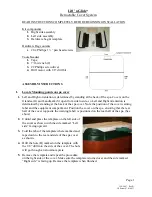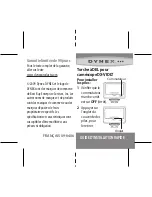
Characteristics—P6047
SECTION
I
CHARACTERISTICS
General Information
The P6047
Probe
is
a
passive
10X
attenuation
probe
with
a frequency response of
DC
to 290
MHz.
It
can be compensated for oscilloscopes or
plug-in
units
having an input impedance of
1
megohm paralleled by
15
to
20
picofarads
and
is
factory
calibrated
for 20 picofarads.
The
probe consists of a small-diameter probe
body assembly, which
is
especially
useful in
compact circuitry, a 3.5-foot or a 6-foot cable,
and a compensating box with a
BNC
connector.
The
compensating box houses a network which
provides optimum transient response when the
probe
is
used with
wideband
oscilloscopes.
The
probe compensation networks for the two cable
lengths differ slightly from one another.
The
probe can be low-frequency compensated to
match the input of the instrument being used
by adiusting the
variable capacitor
through
the hole
in
the compensating box cover. lnter-
nal
adiustments
are
provided for high-frequency
compensation.
CHARACTERISTICS
Bandwidth
The
bandwidth of the
P6047
Probe
is
DC
to
290MHz.
Input
Impedance
The
input impedance of the probe
is
10
meg-
ohms
paralleled by
less
than
10.3
picofarads
for
the
35-foot cable
and
less
than
12
pico-
farads for the 6-foot cable,
at
140 kHz.
See
Figs. 1-2
and
1-3
for input impedance
vs. fre-
quency curves.
Compensating Range
The
probe can be compensated for oscillo-
scopes or plug-in
units
having an input capaci-
tance of
15
to
20
picofarads.
Attenuation
Attenuation
is
10X,
:270
with
plug-in or
oscilloscope having 1-megohm input resistance.
Voltage Rating
The
maximum
DC
+
AC
peak input
voltage
is
500
volts, continuous wave
(CW).
See
Fig.
1-4
for derating curves.
Transient Response
The
risetime of the probe
is
$1.2
nanoseconds.
The
maximum ringing, rounding, and over-
shoot
is
33%.
The
maximum
tilt
is
32%.
Connecting Cable
The
cable
is
made with a special resistive
center which provides
,critical
damping of
re-
flections.
Environmental Capabilities
The
probe
will
operate
normally
at
tempera-
tures
from
—30°C to
+65°C,
and
at
altitudes
to
15,000
feet.
'|-'I




































